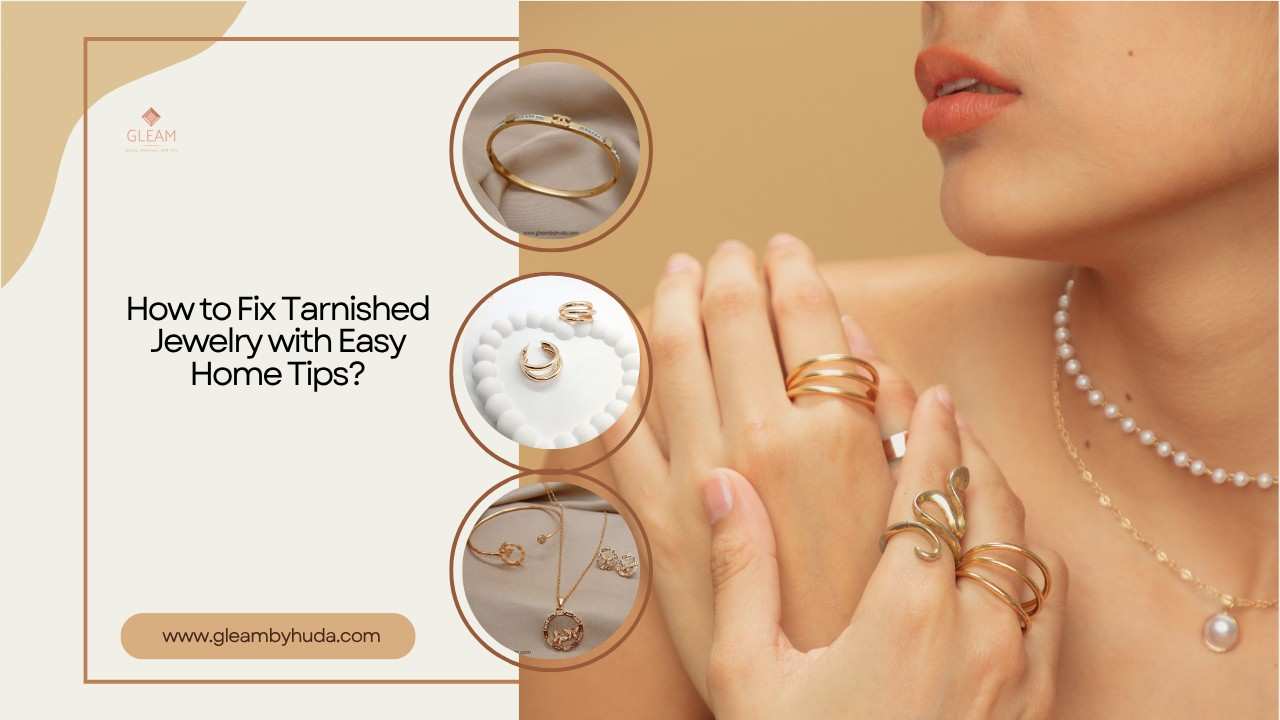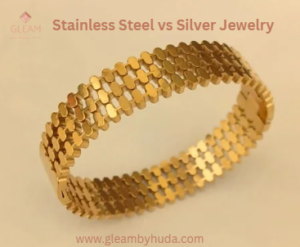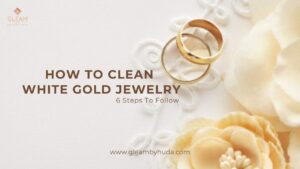Tarnished jewelry looks dull and lifeless. But don’t worry, you can bring back its shine at home. You just need the right method and a little care.
Everyday wear, moisture, and air exposure cause metals to lose their luster. Silver, gold-plated, and copper jewelry are most affected. That’s why regular cleaning is a must.
This guide shares quick and easy ways on how to fix tarnished jewelry. You’ll learn safe home methods using simple items. Say goodbye to dark spots and hello to sparkle!
What Causes Tarnish on Your Jewelry?
Ever wondered why your favorite jewelry starts looking dull or discolored? That’s tarnish—when metal reacts with air, moisture, or chemicals. It’s completely normal and happens to almost all metals over time.
Silver, gold-plated, and copper pieces are especially prone to tarnishing. The main culprits include sweat, lotions, perfumes, and even humidity in the air. These substances trigger a chemical reaction, often called oxidation.
Even storing jewelry wrong can speed up the tarnishing process. Leaving pieces in open air or mixed with others can cause scratches and dark spots. Understanding the causes helps you protect your jewelry better.
Also check out this blog on how to clean gold jewelry at home.
Choose the Right Tarnish‑Removal Method for Each Metal
1. Clean Sterling Silver Safely
Silver jewelry loves to shine, but it easily oxidizes when exposed to air. If your silver ring or chain looks dull, don’t panic, it’s a common issue. You can easily restore its sparkle with a simple baking soda and aluminum foil trick.
Line a bowl with foil, add hot water and baking soda, then drop in the silver piece. This chemical reaction pulls away tarnish without rubbing or damage. Once done, rinse thoroughly and pat dry with a soft microfiber cloth.
For stubborn tarnish, try a silver polishing cloth or paste designed for sterling pieces. Avoid paper towels—they can scratch the surface. Always clean silver gently to keep its luster long-lasting.
2. Revive Gold-Plated Pieces Gently
Gold-plated jewelry looks luxurious but has a delicate outer layer. That layer can fade or chip if you scrub too hard or use harsh cleaners. So, always go gentle when restoring its shine.
Mix warm water with a few drops of mild dish soap. Dip a soft cloth in the solution and gently wipe the piece clean. Rinse with clean water and pat dry without rubbing.
Skip abrasive toothpaste or baking soda here—they can strip the gold layer. Stick to soft tools and gentle cleaners only. If in doubt, use a jewelry-specific gold cleaning solution.
3. Brighten Copper and Brass at Home
Copper and brass jewelry develop a natural patina over time. While some people love that antique look, others prefer a polished finish. Either way, cleaning copper at home is super easy.
Make a DIY paste using lemon juice and baking soda. Gently rub the mixture on the jewelry using a soft toothbrush. Rinse with warm water and dry completely to avoid water spots.
For deeper tarnish, white vinegar works wonders. Soak the piece for a few minutes, then scrub lightly. Your copper jewelry will look as good as new, without a trip to the jeweler.
Check out the latest jewelry trends in Pakistan Here!
Follow These Step‑By‑Step DIY Cleaning Routines
1. Soak Jewelry in a Foil Bath
This method is perfect for silver jewelry and uses a simple chemical reaction to lift tarnish. It’s gentle, effective, and uses common household items.
- Line a bowl with aluminum foil (shiny side up).
- Pour in hot water and add 1 tablespoon baking soda + a pinch of salt.
- Drop the tarnished jewelry into the solution.
- Let it soak for 5–10 minutes while the tarnish transfers to the foil.
- Carefully remove the jewelry and rinse it under lukewarm water.
- Pat completely dry using a soft, lint-free cloth.
2. Apply Baking Soda Paste and Buff
This method works well for stubborn tarnish or intricate designs. Baking soda is a mild abrasive that safely lifts dirt and oxidation.
- Mix 2 parts baking soda with 1 part water to form a paste.
- Use a soft cloth or toothbrush to apply the paste to your jewelry.
- Gently rub in circular motions—don’t press too hard.
- Focus on crevices and textured areas where tarnish hides.
- Rinse thoroughly with lukewarm water to remove all residue.
- Dry fully using a microfiber cloth or soft towel.
3. Rinse Thoroughly and Dry Completely
No matter which method you use, rinsing and drying properly are key to preventing new tarnish. This step protects your jewelry long-term.
- Always rinse your jewelry under clean, lukewarm water.
- Make sure to remove all traces of paste or solution.
- Immediately dry with a soft, absorbent cloth.
- Avoid air-drying, as moisture can trigger oxidation.
- Store only once the piece is 100% dry.
Ask: “Do I HAVE to scrub?” — No, Chemistry Does It for You
You don’t always need to scrub your jewelry like you’re cleaning a stubborn pan. In most cases, a simple chemical reaction does the heavy lifting. Tarnish forms from oxidation, and we can reverse that without scratching the surface.
One of the best non-abrasive methods is the aluminum foil and baking soda soak. When hot water hits the mix, a chemical reaction pulls the tarnish off the jewelry. Your silver gets clean without you lifting a finger (well, almost).
This method is safe, easy, and ideal for delicate or vintage pieces. You avoid harsh rubbing and protect the jewelry’s finish. Let the science do its magic—your bling deserves gentle care!
How to Prevent Future Tarnish?
1. Wear and Wipe Regularly
Wearing your jewelry often actually helps slow down tarnish, especially for silver. The natural oils from your skin can keep it shinier for longer. Just make sure to wipe it gently with a soft cloth after wearing.
A quick polish after each wear removes sweat, dust, and product buildup. This small habit makes a big difference in your jewelry’s appearance. A microfiber or anti-tarnish cloth works best for this.
Skip rough towels or tissues—they can scratch the surface. Stick to jewelry-specific polishing cloths designed to protect delicate metals. You’ll keep the shine without damaging the finish.
2. Store in Airtight, Anti‑Tarnish Bags
Air is one of the biggest reasons jewelry tarnishes over time. When your pieces sit exposed, oxygen and moisture speed up oxidation. To avoid that, store them in airtight containers or zip pouches.
Use anti-tarnish strips or silica gel packets to absorb moisture. These little tools are affordable and make a huge difference. You can find them online or in any jewelry care kit.
3. Avoid Contact with Chemicals and Moisture
Chemicals in perfumes, lotions, and hair sprays can dull your jewelry. Always put your jewelry on last after getting ready. This simple switch protects the metal from harsh ingredients.
Never wear jewelry while swimming or showering. Chlorine, salt water, and soaps speed up tarnishing and can corrode delicate finishes. Even sweating during workouts can take a toll.
If your jewelry does get wet, dry it right away with a clean, soft cloth
When to Call a Jeweler for Professional Tarnish Removal
Sometimes, DIY methods aren’t enough especially when your jewelry has intricate designs or heavy tarnish. If your silver chain or gold ring still looks dull after cleaning, it’s time to call in the experts. A professional jeweler has the right tools and expertise to restore your jewelry’s original shine.
Gemstones can be tricky to clean at home since harsh chemicals or scrubbing might loosen them. If your piece includes delicate stones like opal or pearl, avoid DIY tricks altogether. A jeweler knows how to clean tarnished jewelry without damaging the setting or surface.
You should also consider professional polishing once or twice a year to keep your collection looking its best. Experts use ultrasonic cleaners and polishing machines that go deeper than any home method. This keeps your jewelry not only shiny but structurally safe for the long run.
Check out the affordabe 1 – Caret Earrings collection at gleam by huda Now!
Conclusion
Restoring your favorite pieces is simple when you know how to fix tarnished jewelry the right way. From silver to gold-plated items, these easy DIY methods bring back their shine in minutes. Regular care and smart storage can prevent future tarnish and keep your jewelry looking brand new. For more tips, inspiration, or to shop stunning, tarnish-resistant pieces, visit gleambyhuda.com. Your sparkle deserves to last—and now, you know exactly how to make it happen!
FAQ: Common Questions Answered
Can I clean gemstone jewelry with DIY methods?
Not always! Some gemstones like pearls, opals, and turquoise are too delicate for harsh cleaners. Stick to a soft cloth and mild soap for safe gemstone cleaning at home.
Is baking soda safe for all metals?
Baking soda works great on sterling silver but can scratch gold-plated or delicate finishes. Always check your jewelry type before using abrasive DIY cleaners.
How often should I deep-clean silver jewelry?
Clean your silver every 1–2 months if you wear it regularly. It helps prevent heavy tarnish and keeps that bright silver shine looking fresh.
Can vinegar damage gold-plated jewelry?
Yes, vinegar can strip away the thin gold layer and dull your piece.
What’s the fastest way to restore jewelry shine?
The baking soda and foil method works like magic in minutes. Just soak, rinse, and dry to bring back the sparkle without scrubbing hard.





[…] This is different from tarnish, which is a chemical reaction that can be polished away. If your jewelry tarnishes often, you can check this guide on how to fix tarnished jewelry. […]